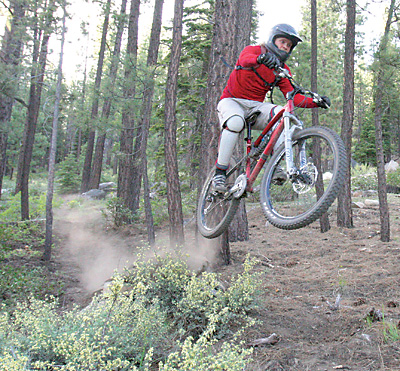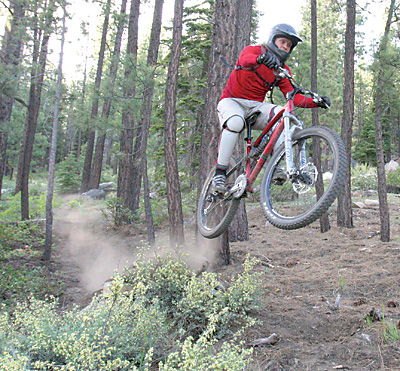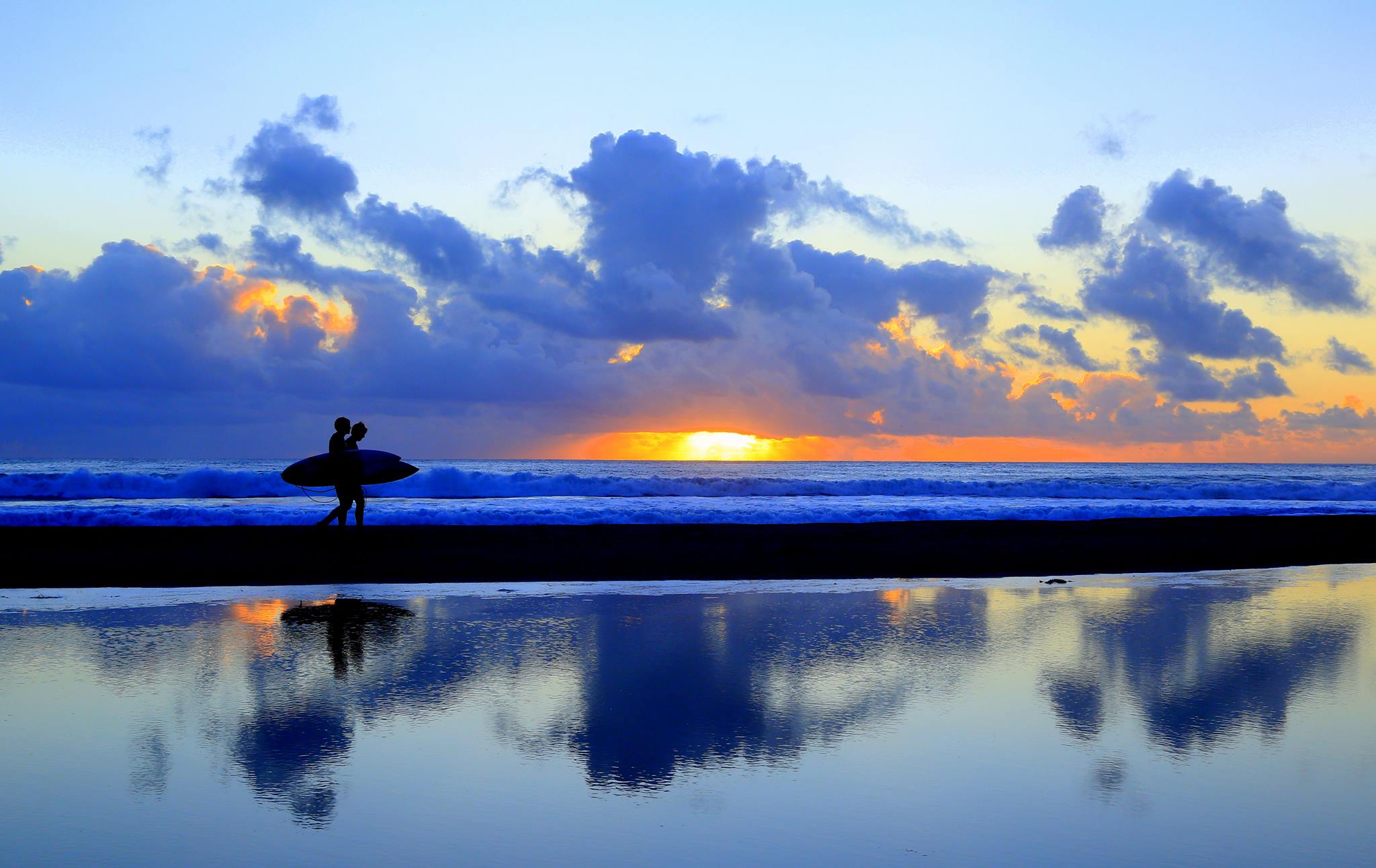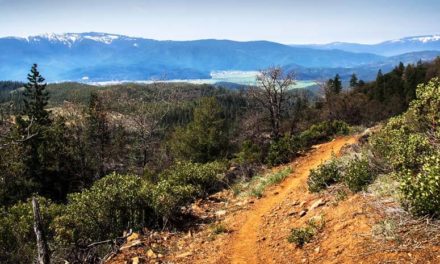- Tahoe’s Nevada Beach Tops the List of Hard-to-Book Campgrounds - 07/17/2024
- Cannabis Watershed Protection Program Cleans Up Illegal Grow Sites - 07/10/2024
- French Fire - 07/05/2024
Fundamentals of Sustainable Singletrack Design
Words and photos by Seth Lightcap
 From the coast to the Sierra crest, more terrain hungry mountain bikers are picking up shovels to improve old trails and create new classics each day.
From the coast to the Sierra crest, more terrain hungry mountain bikers are picking up shovels to improve old trails and create new classics each day.
But if you want to build something that will stand the test of time and countless tires without degrading into an environmental nuisance, you’ll need to follow the principles of responsible, sustainable singletrack design.
For help in assembling some essential guidelines for repairing and building trails, I’ve enlisted the expertise of several trail-building pros: Scott Linnenburger, director of field programs for the International Mountain Bike Association, and from Northstar-at-Tahoe, bike park manager Kyle Crezee and trail builder Kurt Gale.
While these tips won’t answer every dirty question you may have about trail construction, they will steer you clear of the most common pitfalls that plague deteriorating trails. If you’re serious about laying down an epic line that rips the same for the first rider as it does for the thousandth, read on.
Route Selection:
Choosing the right route is the most important element of sustainable trail design. You’ll need to carefully consider every inch of your intended line to guarantee good trail flow and avoid the ravages of erosion.
Start planning by asking questions about your available land. First, do I have permission to build here? “No.” Drop the shovel. Go ride elsewhere. “Yes.” Continue questioning … Where is the ideal trail head/end? How steep is the land? Where is the watershed? What natural features can I tie in? Of those considerations, slope and water are the most critical factors. Steep or flat, wet spots are the number one place to avoid.
Bombing a fall line can be fun, but most soil types cannot support the sustained braking. As a rule, the trail grade should be no more than half as steep as the slope the trail contours, with a maximum grade of 15 percent and an average grade of 10 percent.
To battle erosion, the IMBA recommends a strategy called “rolling contour design.” A trail designed with this strategy has an out-sloped trail tread (inside edge higher than outside) and follows a path that rolls and dips as it surfs across the hillside or ridge line. The intermittent uphill rolls kill speed and add flow while the out-sloped dips drain water. The dips are known as grade reversals. Place a grade reversal anywhere that water will potentially pool or flow down the trail.
Linnenburger swears by rolling contour design: “The end result is a trail that requires less maintenance, feels faster than it is, and lets you stay off the brakes.”
Finished planning? Dial in your layout by flagging the route then start trail cutting. The most durable contour trails are dug into the slope until the trail resembles a bench. Remember to out-slope your bench trails to shed water. As you continue cutting you’ll begin armoring problem areas and designing technical features. Only plan obstacles that feel natural to the location. The goal is always flow. Seek out trusted opinions. Northstar’s Bike Park thrives on cooperative creativity. “We use the rule of threes when making trail decisions: Three people have to agree on the design before any building begins,” says bike park manager Crezee. “Incorporating more riders builds better trails.”
Trail Armoring:
Naked dirt is like the skin on your shins. Both can take abuse, but with continued torment they filet open, fester with wounds, and heal with scars. Treat sensitive trail areas no different than your bony, exposed bits. Slap on the armor. Armor a trail by reinforcing the dirt tread. Areas where water or braking is inevitable should be the first places to protect. Typically brake-scarred locations include jump landings, steeps, and corners. Most armoring methods involve “paving” the trail with a layer or layers of rock. Location and rock access determine what technique will work best. Some areas need built up layers of rock; others you can get away with just flat boulders.
IMBA’s Linnenburger likes to use “five-man rocks” in landing zones. “If you can place two flat rocks that each take the effort of five people in an air landing your work is done.” When armoring with boulders make sure they are completely buried and immovable. If water is flowing underneath they will not stay in place. Building a grade reversal just before an armored section can help. Without access to rocks, wooden boardwalks and erosion-control matting can also make effective armor. If you go with wood, be sure to use rot-resistant lumber.
Building Technical Trail Features:
Technical trail feature design should focus on subtly blending elements into the flow of the trail, increasing the challenge while maintaining safety, and building a structure that can withstand years of weather and abuse. Here are a few tips on adding berms, ladders and logs.
Berms
Berms add serious fun to otherwise ho-hum corners. To build a berm that rides fast and requires minimal maintenance use simple geometry and rock-solid construction. Linnenburger has seen more than a few buzzkill berms and says turn radius is usually the culprit. “The most common problem with berms is that they don’t have a wide enough diameter. If the corner is too tight, riders will always hit the brakes entering and exiting.”
Braking shreds berms into nasty ruts. Wider corners allow more time to negotiate turns and less need to slow down. Choosing the best turn radius takes careful analysis of speed, slope, and soil type. Unless the corner is designed to control speed, bigger is usually better.
To withstand the forces of railing riders, a berm also needs a beefy retaining wall to push against. Building the foundation of the wall out of boulders is a good start. Gale, Northstar’s trail builder, suggests digging before building up. “It’s important to work into the hill. Dig the base of the berm into the dirt. Berm walls that are just piled will never last.” Finish the rock foundation of a berm, by covering and compacting with dirt. Armor the berm with flat stones or pavers if you can’t eliminate ruts.
Ladders and Logs
Ladder bridges and log rides are perfect for crossing wet terrain or adding trailside challenge. But if not built properly they are always the first features to die. Primary concerns are the durability of the wood and the strength of the supporting structure. For ladders, the best material to use is rot-resistant natural wood. As Northstar’s Gale says, “Natural wood will always last longer than your grandma’s old deck!” Ideal woods include cedar, redwood, white oak and manzanita. Avoid soft lumber such as pine. If you must use soft wood, use freshly cut pieces with the bark stripped off.
Here are a few ladder building gudelines:
- Fasten decking pieces (riding surface) to stringers (lengthwise supports) no more than a few inches apart and within an inch of either side.
- Supports should include cross and diagonal bracing.
- Avoid letting wood touch dirt by armoring entrances and exits with rock.
- Always use screws, not nails.
Log rides are simpler to build than ladders but materials and construction are still critical. Again, Linnenburger says the bigger the better. “Use the largest logs you can find. They will rot slower.” Logs should be securely embedded in the ground with stable entrances and exits built from rock. Shaving the log flat can also increase longevity as more riders will stick the log ride rather than fall off and gouge their pedals into it.
Respect and Maintain:
So your trail is complete. The ladders are bomber and the berms are buttery. Time to ride! As you’re riding, pay attention to how the trail conditions evolve. If you notice that a section is getting muddy or rutted don’t delay in repairing or re-routing. Respect the untold hours you put into creating the trail and put in a few more. The ability to easily fix problems before they ruin the experience is what sustainable trail building is all about. For further trail building tips, check out the IMBA’s comprehensive guidebook “Trail Solutions: The IMBA Guide to Building Sweet Singletrack.” To ride amazing trails, visit Northstar’s bike park in Truckee.













